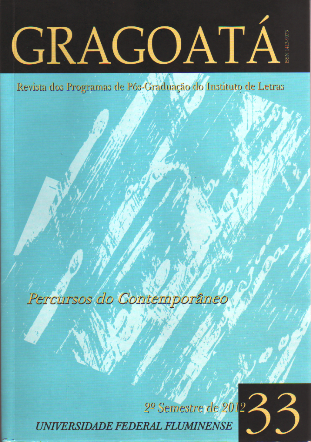Dos escombros à gestação da palavra: José Saramago e Gonçalo Tavares em diálogos simbólicos
DOI:
https://doi.org/10.22409/gragoata.v17i33.33018Palavras-chave:
espaço, teorias do imaginário, símbolo, narrador, guerraResumo
José Saramago e Gonçalo M. Tavares possuem uma arquitetura narrativa bastante diferenciada. Talvez, quase opostas. Um é barroco, ornamentado; o outro é econômico, áspero. Enquanto o primeiro possui como marca indelével a presença de um narrador intruso, excessivo, demiurgo, o segundo faz geralmente uma literatura mais seca, menos digressiva, com frases curtas e de forte impacto. Entretanto, há um José Saramago pouco lido (e estudado), ainda anterior à descoberta do seu narrador conhecido em 1980. É a voz narrativa de O ano de 1993, que traz uma ambientação apocalíptica, que pode ser aproximada à obra Um homem: Klaus Klump. Os dois narradores edificam textos que comungam de uma mesma simbologia, especialmente relacionada à desfiguração do espaço, à derrocada, ao caos, em tempos de guerra. Este artigo analisa, sob a luz dos estudos do Imaginário, especialmente apoiado em Gilbert Durand e Gaston Bachelard, a destruição espacial e as imagens recorrentes e, por vezes, complementares, perceptíveis em “O ano de 1993” e “Um homem: Klaus Klump”.Downloads
Downloads
Publicado
Edição
Seção
Licença
AUTORIZAÇÃO
Autores que publicam em Gragoatá concordam com os seguintes termos:
Os autores mantêm os direitos e cedem à revista o direito à primeira publicação, simultaneamente submetido a uma licença Creative Commons Atribuição 4.0 Internacional (CC BY 4.0), que permite o compartilhamento por terceiros com a devida menção ao autor e à primeira publicação pela Gragoatá.
Os autores podem entrar em acordos contratuais adicionais e separados para a distribuição não exclusiva da versão publicada da obra (por exemplo, postá-la em um repositório institucional ou publicá-la em um livro), com o reconhecimento de sua publicação inicial na Gragoatá.
A Gragoatá utiliza uma Licença Creative Commons - Atribuição CC BY 4.0 Internacional.











